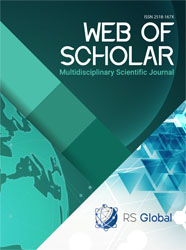POSSIBILITIES OF PURIFICATION OF HEAVY METALS CONTAMINATION IN SOILS
Abstract
Methods of neutralisation of different types of soils contaminated with heavy metals are studied. Certain strains of microorganisms have been selected, local microflora has been studied and identified at the genus level in laboratory conditions. Considering the conducted works, development of modified forms of humic acids, stimulation of local microorganisms and creation of geochemical barriers using local natural raw materials is recomended. Obtained results makes possible to develop comprehensive and rational model by means of inovative technologies for effective purification of soils contaminated with heavy metals.
References
Urushadze T. F, Manakhov D. V. Radioactive contamination of the soils of Georgia. Annals of Agrarian Science. 2017; 15: 375-379.
Dolidze A., Mikadze I., Chkhaidze K., Kavtaradze N., Dolidze L., Barbakadze N., Uridia R. Possibilities of reducing of ecological danger of polluted sites by radionuclides, precipitated from atmosphere. Transactions of Petre Melikishvili Institute of Physical and Organic Chemistry, Tbilisi, 2011: 81-83
Castro L, Blázquez M, González F, Muñoz J, Ballester A. Heavy metal adsorption using biogenic iron compounds. Hydrometallurgy. 2018; 179: 44–51.
Yadav S.K. Heavy metals toxicity in plants: An overview on the role of glutathione and phytochelatins in heavy metal stress tolerance of plants. South African Journal of Botany. 2010; 76: 167–179.
Ившина И. Б, Куюкина М. С, Костина Л.В, Тищенко А. В. Извлечение тяжелых металлов из техногенно загрязненных городских почв. Аграгный вестник Урала. 2014. 11(129).
Савич В.И, Белоухов С.Л, Никиточкин Д.Н, Филлипова А.В. Новые методы очистки почв от тяжелых металлов. 2013. 4 (42): 216-218.
Nzihou A, Sharrock P. Role of Phosphate in the Remediation and Reuse of Heavy Metal PollutedWastes and Sites. Waste Biomass Valor (2010) 1:163–174
Rafael Celis R, M. Carmen HermosÍnM. C, Cornejo J. Heavy Metal Adsorption by Functionalized Clays. Environ. Sci. Technol. 2000, 34, 21:4593-4599.
Christofi N, Ivshina I.B. Microbial surfactants and their use in field studies of soil remediation. J. Appl. Microbiol. 2002, 93: 915–929.
Kostina L. V, Kuyukina M. S, Ivshina I. B. Evaluation of Rhodococcus biosurfactant potential towards the remediation of heavy metals from contaminated soils of Sverdlovsk region. Вестник Пермского Университета. 2014. 4:73-77.
Views:
342
Downloads:
185
Copyright (c) 2019 The authors

This work is licensed under a Creative Commons Attribution 4.0 International License.
All articles are published in open-access and licensed under a Creative Commons Attribution 4.0 International License (CC BY 4.0). Hence, authors retain copyright to the content of the articles.
CC BY 4.0 License allows content to be copied, adapted, displayed, distributed, re-published or otherwise re-used for any purpose including for adaptation and commercial use provided the content is attributed.











